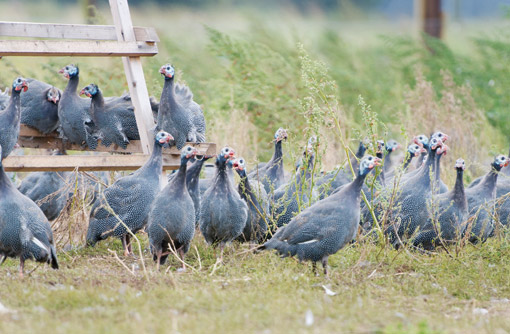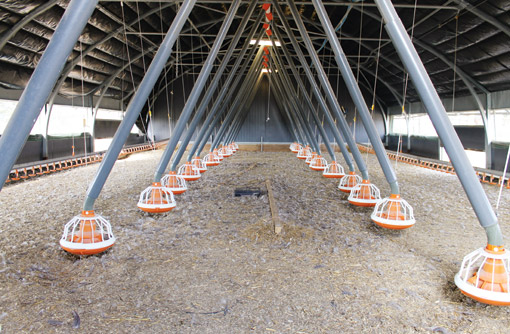Commercial-scale guinea fowl find their niche

Guinea fowl are hardly new to the British countryside, but production on a commercial scale is, as Philip Clarke discovers
With five kilometres of high-wire fencing, wide open paddocks and primeval looking creatures running around in packs, it really does resemble something out of Jurassic Park.
At least, that is the name that Harry Irwin and his staff use to describe the 25-acre plot that is home to some 20,000 guinea fowl – the latest enterprise in his free-range poultry business, near Attleborough in Norfolk.
Trial work into rearing guinea fowl on a commercial scale first started on the Woodfield site about 18 months ago. But the idea goes back further than that.
As organic chicken sales started to slide following the 2008 recession, Mr Irwin, who runs Free Range Chicken Ltd, wanted an alternative and decided that guinea fowl could be the next niche, or rather “a niche within a niche”.
“Up until now, the vast majority of guinea fowl on sale – both in retailers and restaurants – has come from France and Belgium,” he explains.
“As pinioning is widespread within the French guinea fowl industry the challenge for us was to develop a system which allowed free-range birds to be kept without any mutilations”
Mr Irwin tried a range of systems, using different strains in varying flock sizes. He also worked closely with Freedom Foods to develop a high welfare spec that meets retailers’ requirements. “The volumes are only ever going to be fairly small, so it makes sense to start from a high baseline.”
Fertile eggs are imported weekly from France and hatched in a small game hatchery in Norfolk. Mr Irwin believes it is important to hatch them in the UK, rather than bringing in day-old chicks, so the birds can be sold as “British”.
Once hatched, the chicks or “keets” are placed in one of 12 mobile arcs in groups of 1,200, where they are housed for the next four or five weeks as they put on weight and feathers. Good feathering is particularly important to protect the birds’ carcasses from scratches caused by sharp claws.
“Guinea fowl chicks are very different to chickens,” Mr Irwin explains. “They are smaller – about 30g at day-old compared with 35-40g for chicken – and need more heat and to be managed in smaller colonies. It’s a bit like a cross between chicken farming and game farming.”
Lighting is also crucial. The keets are extremely nervy and the first reaction to turning on lights is for them to run away, which can lead to smothering. Natural lighting is used at Woodfield and any changes are done very gradually.
At between 28 and 35 days, the popholes are opened and the birds get to go outside for the first time. “By this time they are sufficiently well feathered and hardy to cope with the weather and predators, such as crows and seagulls.”
The ranges are on very free-draining sandy soil, with tall grasses and high, home-made perches to satisfy the birds’ natural instincts.
The guinea fowl graze heavily, but also need a high specification ration, similar to a game bird diet, which is supplied by Porters of Navenby in Lincolnshire. “Guinea fowl have a low appetite, but need to take in lots of nutrients both to build up meat and feathers.”
Feed conversion rates are particularly high – Mr Irwin estimates that each bird eats about 6.5kg of feed to reach a slaughter weight of 1.85kg – reflecting the fact that they run around all day and often take flight, burning up fuel.
The birds have access to the range until they are ready for slaughter at 82 days, so exceeding the free-range marketing requirement to spend at least 50% of their lives outside.
Mortality, which includes “escapees”, is expected to be low. “It is early days yet, but we are budgeting on 5%.”
Once ready for slaughter, the flock is transported to Gressingham Foods at Redgrave in south Norfolk for processing. This is a weekly operation, with each crop produced on a 14-week production cycle.
The first guinea fowl from Woodfield went on sale in Marks and Spencer stores in October, retailing at £9 apiece. Supermarket group Morrisons has also recently started selling them as an own-label product.
Mr Irwin is hopeful that other retailers may come on board soon, and has been trialling indoor guinea fowl with the aim of offering consumers a slightly cheaper product.
He has an eye on the catering market too, but sees supermarkets as the key to building up turnover.
“We aim to offer our customers something different,” says Mr Irwin. “The flavour of guinea fowl is less gamey than pheasant; it offers better meat yield than duck and eats extremely well.
“Yes, it is a bit of a novelty. But it is growing in popularity and, being wholly British, we have a good story to tell.”
Mobile arcs

The guinea fowl at Woodfield are kept in mobile chicken arcs, imported as flat packs from French housing manufacturer Le Triangle. They are modified with the feed hopper attached to an extended sub-frame, enabling the whole unit to be picked up and relocated in one operation.
There is double the number of popholes as on a standard hen house, so one side can be closed off on a windy day and still respect the Freedom Foods standard of 4m of popholes per 100sq m of floor area. Netting is erected around the arcs to keep birds from perching on the roofs. Mr Irwin is also trialling automatic weighers to help monitor weight gain as he builds up his understanding of guinea fowl production
